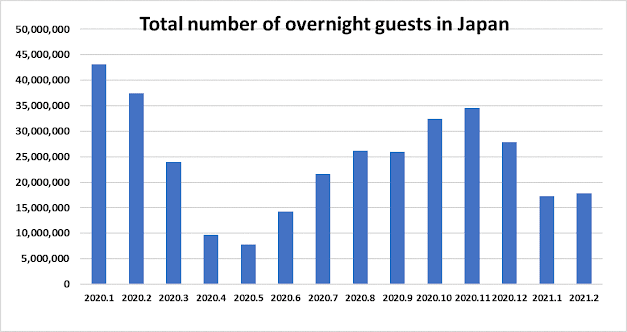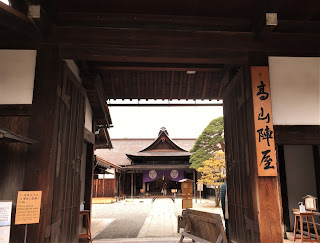The tourism industry in Takayama City hopes vaccination rollout to proceed as planned as it prepares to accept tourists as before
Japan has declared states of emergency for the third time three months before the Tokyo Olympics
Japan has declared states of emergency for
Tokyo, Osaka and two other prefectures on April 23 as the country desperately
contain a resurgent coronavirus pandemic three months before the Tokyo
Olympics. The measures took effect on April 25 and the government hopes to end
it on May 11. Large department stores, shopping malls, amusement parks and
movie theaters were asked to close. Restaurants and karaoke parlors were asked
to shorten their hours, and serving alcohol was banned. Those measures also hit
tourism industry hard.
Overseas guests and their consumption plummeted due to the pandemic
According to the accommodation travel statistics released by the Japan Tourism Agency, the number of guests in February 2021 was 17.85 million, a decrease of 52% from the same month of the previous year. With government's support measure for tourism industry, "Go To Travel" program being suspended nationwide from the end of December 2020 due to the spread of the new coronavirus infection.
In addition, a state of emergency was issued in some areas in February causing travel demand remained sluggish since then. In particular, the number of foreign guests was 240,000, a 95% decrease from the same month of the previous year, representing a remarkable decrease in guests in entire hotels and inns.
The Japan Tourism
Agency estimates that the amount of travel consumption by foreigners visiting
Japan in 2020 was 744.6 billion yen of which most amount thought to be spent
from January to March in 2020 before the effects of the new coronavirus has
started to appear. It was 84.5% decrement compared to the consumption in 2019.
Spread of the new coronavirus has been preventing overseas visitors from
entering Japan for sightseeing purposes with the number of visitors to Japan to
nosedive.
Takayama Spring Festival was resumed in downsized version with festival floats displayed only at their warehouses
The epidemic of the new coronavirus has had a major impact on the tourism industry in Takayama City, Gifu Prefecture too, which is one of Japan's leading tourist destinations. Tourists walking along old township (Furui-machi-nami) in Takayama, well known district for its Edo period houses remaining in the area have decreased significantly after the pandemic.
Although the tourism industry is suffering from headwinds, some signs showing resilience of the industry are beginning to become tangible. For example, Takayama Spring Festival which was canceled completely in 2020 was resumed on April 14 and 15 although its scale was downsized with the line-up of floats, the karakuri puppet shows and the night festival called off. Twelve festival floats were displayed at their warehouses during the festival so that visitors could take a glance at those floats. As for the autumn festival, it is expected to be held as usual if the vaccination rollout is proceeded as planned.
In addition, a campaign has been launched in the Hida region which
utilizes the electronic local currency "Sarubobo Coin" through
visitor’s smartphones. A maximum of 8,000 points (equivalent to 8,000 yen) are
given to inns and hotel guests in the city according to the reservation amount,
aiming to increase consumption in the city and promote accommodation facilities
in the area to accept cashless payment.
Takayama Jinya takes all measures to prevent Coronavirus infections
Takayama Jinya, a famous tourist attraction in Takayama City as it is the only existing building used as a government office in Edo period attracting many visitors every year.
Here, it has devised ways to prevent the facility from becoming crowded so that tourists can tour the facility without having been worried to get infected in the crowds. In order to avoid congestion in the facility, the number of visitors is kept under certain level. The situation of crowds is always posted on a display at the entrance of the facility and on its website so that visitors can avoid crowded areas.
In addition, it has started a service that allows visitors to listen to
audio commentary from their smartphones in seven foreign languages including
English and Japanese so that visitors can move efficiently and shorten staying
time. It also enables visitors to get knowledge on exhibitions in the
facilities without participating guided tours. Through these efforts, Takayama
Jinya improves services hoping to attracts more tourists after the pandemic.
Coronavirus infection continues, but tourism industry prepares to accept as
many tourists as before when the infection subsides after vaccination rollout
proceeds as planned.






Comments
Post a Comment